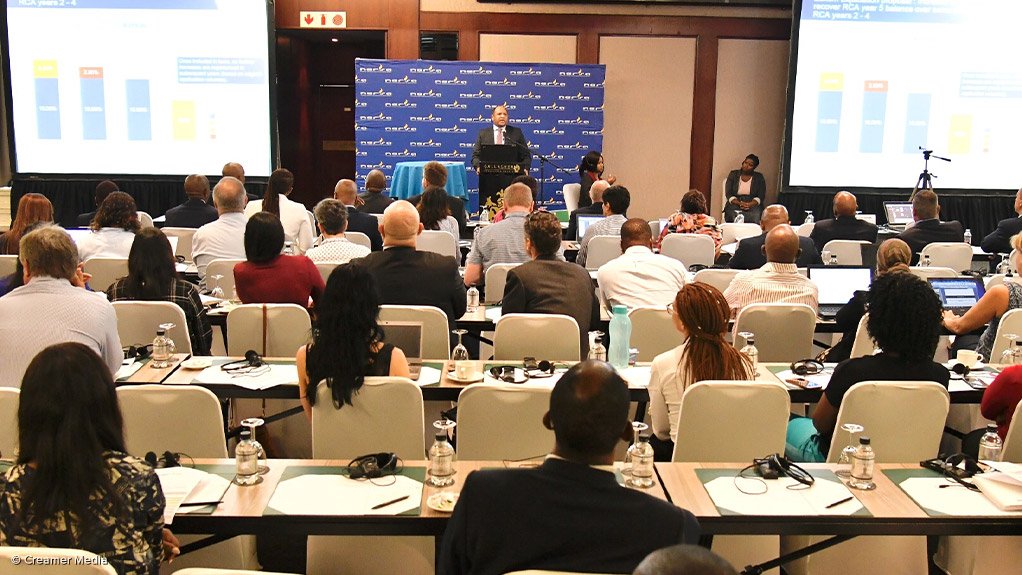Eskom says the Electricity Pricing Determination Rules (EPDR) approved by the National Energy Regulator of South Africa (Nersa) in December cannot be implemented for the 2025/26 financial year as proposed by the regulator, owing to the time it takes to prepare, adjudicate and approve such applications. In addition, the utility has questioned whether the rules are implementable at all given how far they deviate from established standards used globally for determining electricity tariffs.
Following a period of public consultation, Nersa approved the EPDR late last year. These tariffs are applicable for all licensees providing electricity to customers.
The prevailing multiyear price determination (MYPD) framework and methodology has been used to determine Eskom’s yearly allowable revenue since 2006. That allowable revenue is then divided by approved sales volumes for the period to determine average tariffs. The detailed Eskom tariffs to be charged in any given year are then determined by the Eskom Retail Tariff and Structural Adjustment methodology. For municipalities, Nersa is required to base tariffs on the cost of supply framework.
Nersa says the revision to the way tariffs are determined has been informed by changes under way in the electricity supply industry, including the emergence of new participants in generation and trading and the unbundling of Eskom.
Tariffs, it argues, will no longer be aggregated and will instead be determined for each licensed activity along the value chain – including generation, transmission, distribution and trading – based on the fixed costs, variable costs and customer-specific costs allowed by the regulator.
Nersa has already acknowledged the potential difficulties in transitioning from the MYPD to the EPDR and has outlined two possible routes, described as Plan A and Plan B, for introducing the new framework. It has also noted that the MYPD was introduced even though the methodology was not fully finalised in 2006.
However, Eskom GM for regulation Hasha Tlhotlhalemaje does not believe the EPDR is implementable at all and argues that neither Plan A nor Plan B can be implemented in 2025/26 as proposed, as neither plan fully accounts for the time it takes Eskom to prepare a submission and meet the relevant legislative requirements.
These timing requirements have been reinforced in recent court judgments and orders, which have stipulated that only a methodology that is in place 18 months ahead of a new tariff adjustment can be applicable. That being the case, the new rules and associated methodology would have to have been approved by September 2023 for it to be implemented for the 2025/26 tariff period, which starts on April 1 next year.
Furthermore, Tlhotlhalemaje argues that the EPDR approved by Nersa in December is not a complete set of rules, but rather an approach to determining tariffs based on individual customer profiles and not the system profile.
“This is not possible and has not been implemented anywhere in the world and we think it will result in complete chaos,” she says.
While asserting that it will take Eskom at least two years to adjust to any new approach, she argues that it could take even longer for other industry participants, such as independent power producers (IPPs) and traders, given that they have had little experience of Nersa’s tariff processes.
“Before this can be implemented – and assuming it is implementable – a complete understanding of the process and requirements is needed.
“This is not included in the rules at the moment.”
She notes, too, that because all licensees will be expected to provide Nersa with information before tariffs can be determined, practical tools, such as clear forms and formulas, are also required and such documentation has not yet been published or consulted.
“If Nersa wishes to change government policies, such as the Electricity Pricing Policy, these policies need to be changed by the relevant government departments before rules can be developed, not the other way round.”
Guidance could also be provided once the Electricity Regulation Amendment legislation is finalised, as proposed transitional arrangements are likely to be included. “Nersa will then be empowered to make the required decisions.”
Tlhotlhalemaje argues that it is also currently impossible, given what has been published, to assess the potential impacts of the proposed changes on tariffs.
“Customers do not know whether prices will double, or halve, it is a complete black box.”
Asked by Engineering News how the tariffs can be disaggregated absent a transition from the MYPD to the EPDR, Tlhotlhalemaje notes that Eskom has submitted a Retail Tariff Plan that addresses cost reflectivity at the generation, transmission and distribution levels..
“This was not approved by Nersa, but a revised submission will be made to meet the implementation timeframe from 1 April 2025.”
Eskom, she highlights, has always made ringfenced revenue applications for generation, transmission and distribution and that it is thus possible for the regulator to make ringfenced revenue determinations in terms of the existing methodology.
Tlhotlhalemaje did not comment on whether tariff disaggregation would be sufficient for bondholders to provide consent for the restructuring of Eskom into three independent divisions, as is required for the operationalisation of the National Transmission Company South Africa (NTCSA) from April 1 onwards.
Bondholder consent remains the last outstanding condition precedent, with the NTCSA having received its three licences from Nersa and with an independent board having also been appointed.
EMAIL THIS ARTICLE SAVE THIS ARTICLE ARTICLE ENQUIRY
To subscribe email subscriptions@creamermedia.co.za or click here
To advertise email advertising@creamermedia.co.za or click here











